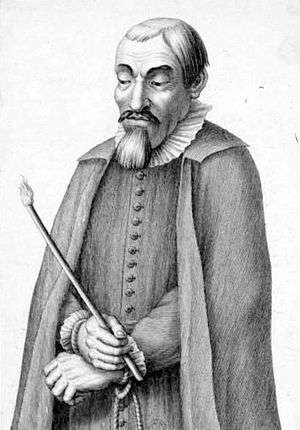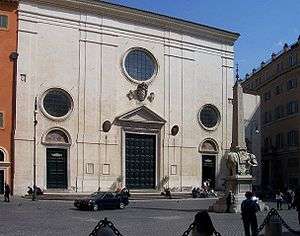Miguel de Molinos

Miguel de Molinos (30 June 1628 – 29 December 1696) was a Spanish mystic, the chief representative of the religious revival known as Quietism.
Biography
He was born in 1628 near Muniesa (Teruel),[1] in Aragon, a village around 60 miles south of Zaragoza. His birthdate is unknown, but church records indicate he was baptised on 29 June 1628.[2] He moved to Valencia in his youth and undertook religious education with the Jesuits there at the College of St Paul.[3] He was ordained in 1652, and seemingly took his doctorate shortly thereafter, though it is unclear when or where (both the University of Valencia and the College of St Paul granted doctorates). On 4 June 1662, Molinos was admitted to the local chapter of the School of Christ, a religious brotherhood that would play an important role in his later life in Rome. He seems in these early years in Valencia to have held a number of secondary roles in the chapter’s leadership, at least one of which earned him a place on the chapter’s governing body.[3]
In July 1663, Molinos was chosen to travel to Rome to support the cause of the beatification of, and to report back to Valencia on, the Venerable Francisco Jerónimo Simón (d1612), a secular cleric and beneficer of the parish of St Andrews in Valencia. He left Spain in late 1663; he would not return.[3]
There is almost no specific evidence of Molinos’s activities in Rome in the years 1663-1675. It is known that Molinos was affiliated with the Roman chapter of the School of Christ (and, by 1671 at the latest, had become its leader).[3] He also became well known as a spiritual director – and it was in this role that he gained prominence as the leading advocate of the teaching and practice that would come to be known as Quietism. He was a regular correspondent with Princess Borghese, and counted as an admirer, Cardinal Benedetto Odescalchi, who in 1676 became Pope Innocent XI. He also paid frequent visits to the house of the exiled Christina, Queen of Sweden. He was also in these years working on the case of the Venerable Simón; by 1675, however, Molinos had to admit to his superiors in Valencia that the Congregation of Rites had refused to reconsider the case. Molinos’s royal commission and line of credit were revoked, and he was deprived of his official position in the Valencian delegation in Rome.[3]
In the same year, 1675, Molinos published his most famous work, the Spiritual Guide. The initial Spanish edition was quickly followed by an Italian translation entitled Guida spirituale, che disinvolge l'anima e la conduce per l'interior camino all' acquisito della perfetta contemplazione e del ricco tesoro della pace interiore (Spiritual Guide, which releases the soul and conducts it through the interior path to acquire the perfect contemplation and rich treasure of interior peace). The work was published with the usual approval from the ecclesiastical authorities – the book received the imprimatur from the Dominican Raimondo Capizucchi, the pope’s own theologian, and the book opened with approbations by clergy of the Trinitarian, Franciscan, Carmelite, Capuchin and Jesuit orders.[3] This was followed soon after in 1675 by a brief Trattato della cotidiana communione (Brief Treatise on Daily Communion, in which Molinos argued that those who wished to receive the Eucharist daily should not be denied by their confessor, so long as they were in a state of grace). Again, this work was approved by the censors of several orders.[3]
Molinos’s writings was clearly extremely popular. By 1685 seven editions had been printed in Italy and three in Spain. Translations of the book would be made into Latin (1687), French (1688), Dutch (1688), English (1688), and German (1699) [3]
The Quietist controversy

The first attack on Molinos’s Guide (though without specifically mentioning the Guide or Molinos) appeared in 1678, written by Gottardo Bell’huomo. Molinos evidently felt that Bell’huomo’s book could not be ignored, because shortly after he wrote (though never published) an apologia for his Guide entitled Defence of Contemplation, aiming to defend the Guide against charges of theological innovation. Specifically, he marshalled a long list of past writers and saints (including Francisco Suarez and Jean-Joseph Surin) in order to demonstrate that the Guide’s principal thesis – that in order to pass to the state of contemplation one must leave behind meditative practices (even though, aware of the focus of the writings of Ignatius of Loyola on meditation, and the likelihood that Jesuit writers would react poorly to any perceived attack on Ignatius’s thought, he was quick to emphasise that these are certainly an important stage of the spiritual life) – was a well-established part of church doctrine. Instead of publishing the book, Molinos took up his case with the superior general of the Jesuits, Giovanni Paolo Oliva. In a series of letters from February 1680 onwards, Molinos sought to assure Oliva that he had nothing but praise and respect for the Jesuits and their spirituality.[3]
A second moment of suspicion against Molinos arose in 1681. In March 1680, the Jesuit preacher Paolo Segneri wrote to Oliva, proposing a book defending meditation against the quietists’ teaching. Oliva encouraged him and forwarded copies of the letters he had recently sent to Molinos. Later in 1680, a book was published in Florence, titled Concordia tra la fatica e la quiete nell' orazione (Agreement Between Effort and Quiet in Prayer), with Oliva’s name signed as imprimatur. The book attacked Molinos’s views, though without mentioning his name.[3]
During 1680-1681, a series of responses appeared from both the quietists and the Jesuits. The matter was referred to the Inquisition. In late 1681, it pronounced that the Guida spirituale was perfectly orthodox, censured Segneri, and placed his book on the Index (later in 1681, Bell’huomo’s work was also placed on the Index).[3]
The apparent Quietist victory, however, was short-lived. It is unclear why exactly this happened, though one factor suggested has been disquiet caused in Rome the flourishing of Quietism outside Rome, and the reaction this was causing among its opponents.[3] On 18 July 1685, Molinos was arrested by the pontifical guards and imprisoned in the Castel Sant’Angelo. At first his friends were confident of an acquittal, and it seems that many in Rome remained sympathetic to his beliefs, but matters gradually turned against him.[3]
In spring 1687, Molinos was brought before a tribunal of the Holy Office of the Inquisition and asked to explain his teaching, with 263 questionable propositions from his works at stake. Although initially defending them, by May 1687 his attitude had changed and he confessed his errors of conduct and teaching and waived his opportunity to present a defence. By July, the tribunal had isolated 68 objectionable propositions and had prepared articles of censure for each.[3]
On 23 August 1687, the entire case was read to the cardinal inquisitors, and on 2 September Molinos’s sentence (life in prison) was announced.
On 3 September Molinos made a public profession of his errors in the Dominican Church of Santa Maria sopra Minerva. On 20 November Pope Innocent XI ratified his condemnation in the bull Coelestis Pastor, condemning 68 propositions from the Guida spirituale and other unpublished writings of its author.
Molinos died nine years later in the prison of the Holy Office on 29 December 1696.[3]
Later reputation
For the last three centuries, Molinos has chiefly been known as the main proponent of the most fundamental mystical heresy in Catholicism, a heresy which has come to be the touchstone for doctrinal judgements about correct and incorrect claims for mystical contact with God. Most assessments of him have been accordingly negative.[4]
In the second half of the twentieth century, however, the assessment of Eulogio Pacho has been somewhat more circumspect, aware of the problematic bias in the various sources on Molinos. Bernard McGinn is not entirely forgiving of Molinos as a person, pointing out that it seems likely that he did, as he was accused, engage in sexual misconduct with some of his penitents during his work as a spiritual director. McGinn, however, is keen to point out how far the errors condemned in the bull Caelestis Pater do not in fact exist in the Spiritual Guide. Rather, he argues, the imprecision and lack of qualifications in Molinos’s work left him open to attack, and this was exacerbated by the fact that his book (with its various ambiguities) focused on certain issues (notably contemplation over meditation, interior quiet over vocal prayer, and passivity over pious action) which had become heated debates in the preceding century.[5]
Henry Longfellow wrote a sonnet about him. William James, in The Varieties of Religious Experience said he was a ‘spiritual genius’ .[6]
See also
Notes
- ↑
 Goyena, Antonio Pirez (1913). "Miguel de Molinos". In Herbermann, Charles. Catholic Encyclopedia. New York: Robert Appleton Company.
Goyena, Antonio Pirez (1913). "Miguel de Molinos". In Herbermann, Charles. Catholic Encyclopedia. New York: Robert Appleton Company. - ↑ , p3.
- 1 2 3 4 5 6 7 8 9 10 11 12 13 14 15 Robert P Baird, 'Introduction: Part One', in Miguel de Molinos, The Spiritual Guide, ed and trans by Robert P Baird, (New York: Paulist Press, 2010), pp1-20.
- ↑ Paul Dudon, Le Quiétiste Espagnol: Michel Molinos (1628-1696), (Paris: Gabriel Beauchesne, 1921) and Ronald Knox, Enthusiasm, (Oxford: OUP, 1950) are both highly negative.
- ↑ Bernard McGinn, 'Introduction: Part Two', in Miguel de Molinos, The Spiritual Guide, ed and trans by Robert P Baird, (New York: Paulist Press, 2010), pp21-39.
- ↑ 'Introduction: Part One', in Miguel de Molinos, The Spiritual Guide, ed and trans by Robert P Baird, (New York: Paulist Press, 2010), pp1-20.
References
-
 This article incorporates text from a publication now in the public domain: Chisholm, Hugh, ed. (1911). "Molinos, Miguel de". Encyclopædia Britannica (11th ed.). Cambridge University Press.
This article incorporates text from a publication now in the public domain: Chisholm, Hugh, ed. (1911). "Molinos, Miguel de". Encyclopædia Britannica (11th ed.). Cambridge University Press.
Further reading
Spanish editions
- Miguel de Molinos, Guía Espiritual: Edición critica, introducción y notas, edited with an introduction by José Ignacio Tellechea Idígoras, (Madrid: Fundación Universitaria Española, 1976).
- Miguel de Molinos, Defensa de la contemplación, edited with a preliminary study and notes by Eulogio Pacho, (Madrid: FUE/Univ. Pontificia de Salamanca, 1988) [also include Molinos’s Scioglimento ad alcune obiettioni fatte contra il libro della Guida Spirituale]
English translations
- Miguel de Molinos, The Spiritual Guide, ed and trans by Robert P Baird, (New York: Paulist Press, 2010) [prepared from the 1976 critical edition]
- The Unabridged Collected Works of Michael Molinos and Francois Fenelon (Kahley House, 2006)
- The Spiritual Guide (SeedSowers, 1972)
Secondary literature
- Eulogio Pacho, 'Molinos (Miguel de)', in Dictionnaire de Spiritualité, vol 10, (1980), ed by Marcel Villier et al., 17 vols, (Paris: Gabriel Beauchesne, 1937-1994).
- Christian Renoux, 'Quietism', in The Papacy: An Encyclopedia, vol 3, edited by Philippe Levillain, 3 vols, (London: Routledge, 2002)
- Ronald Knox, Enthusiasm, (Oxford: OUP, 1950)
- Paul Dudon, Le Quiétiste Espagnol: Michel Molinos (1628-1696), (Paris: Gabriel Beauchesne, 1921)
- Carl Emil Scharling, Michael de Molinos (Ger. trans. from Danish; Gotha, 1855)
- Heinrich Heppe, Geschichte der quietistischen Mystik (Berlin, 1875).
- H. Delacroix, Études d'histoire et de psychologie du mysticisme (Paris, 1908). [On Quietism]
- J. H. Shorthouse's romance, John Inglesant (1881). [A brilliant, but very fanciful, account of Molinos and his doctrines.]
- Santiago Asensio Merino, En el centro de la nada. Venturas de Miguel de Molinos. Ed. LiberFactory. Madrid 2014. ISBN 978-84-9949-439-5. [Fiction]